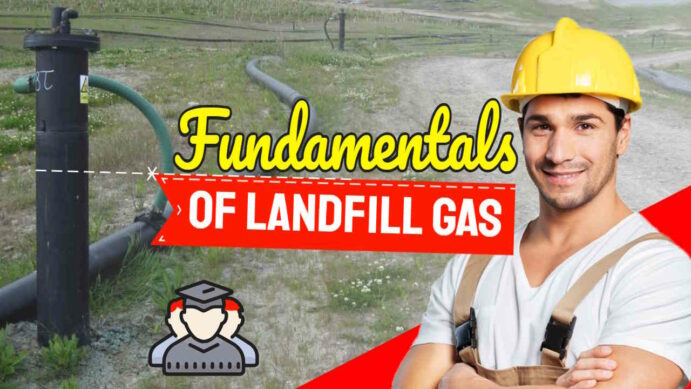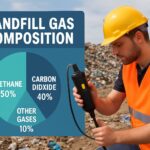Understanding the fundamentals of landfill gas is crucial for environmental researchers, waste management professionals, and many others engaged in addressing climate change. A natural byproduct of organic material decomposition in landfills, this flammable gas plays a substantial role in global warming due to its composition. While not odorous if well managed it is closely associated with landfill gas odour problems if not contained and extracted, and similarly great care is needed to avoid explosion hazards.
As it primarily contains methane and carbon dioxide – both potent greenhouse gases – efficient landfill gas management can significantly contribute towards mitigating climate change effects.
On this website, we provide the following sub-section topic areas for visitors to follow and find out more about the fundamentals of landfill gas
Landfill Gas Composition
The composition of landfill gas varies, but it’s predominantly made up of approximately 40% to 60% methane. The rest includes carbon dioxide accompanied by small amounts of other gases.
Organic material breakdown during waste decomposition leads to these emissions, making landfills major contributors to the rise in atmospheric greenhouse gases. Carbon dioxide has long been known as a greenhouse gas but worth noting is that methane's heat-trapping ability is much stronger which makes managing its emissions incredibly important.
More About Landfill Gas Composition
Landfill Gas Production
Landfills are more than mere dumping grounds; they also double as engines for generating methane-rich gases through organic material decay. To put this into perspective, one tonne of biodegradable waste can yield roughly 400-500 cubic meters of landfill-gas potential—a startling statistic that highlights the urgent need for comprehensive landfill-gas extraction strategies.
Landfill Gas-to-Energy
Methane production from landfills might be an issue if left unchecked—however with effective energy conversion technologies such as cogeneration or using engines designed specifically for LFG utilization—it represents an opportunity too promising not to exploit!
By converting collected landfill gas into renewable electricity and heat, we will reduce reliance on fossil fuels while also tackling our greenhouse emission problems head-on—an ideal way forward toward sustainable energy solutions.
Why Spend Time Understanding the Fundamentals Of Landfill Gas?
In the realm of waste management, understanding the fundamentals of landfill gas (LFG) is crucial. This natural byproduct is generated when organic material in landfills undergoes decomposition.
The composition of LFG primarily includes two potent greenhouse gases – methane and carbon dioxide, accounting for about 50 percent each.
As environmental researchers and sustainability advocates investigate ways to combat climate change, landfill management becomes a focus due to significant methane production occurring within these sites.
Each tonne of biodegradable waste can produce around 400-500 cubic meters of LFG with substantial amounts of methane, thereby contributing substantially to global warming.
For landfill operators and energy companies, it isn't all doom and gloom; there's potential for utilising this flammable gas as a renewable electricity source through cogeneration systems using landfill gas engines.
By transforming emissions into usable power, not only do we reduce harmful atmospheric contributions but also support localised energy production serving wider community needs.
To optimise the useable yield from LFG extraction, efficient gas collection methods are employed with regular monitoring protocols in place for managing emission levels effectively.
Harnessing this robust system could pave the way towards innovative waste management solutions that directly address climate change impacts while promoting sustainable practices throughout industry operations.
A Short Introduction to Landfill Gas Basics
Are you curious about the impact and potential of landfill gas on our environment? Digest this – roughly 50 percent of landfill gas is actually methane, a key player in climate change.
This article will explore the fundamentals from what constitutes landfill gas, to how we can harness its power for renewable energy sources. Ready to delve into an unseen world where waste becomes wealth? Let's dive in!
Key Takeaways
- Landfill gas, primarily composed of methane and carbon dioxide, is a significant contributor to global warming and climate change.
- Each tonne of biodegradable waste can produce around 400 – 500 cubic meters of landfill gas with substantial amounts of methane.
- Effective collection methods and utilization techniques can convert landfill gas into renewable electricity and heat, reducing greenhouse gas emissions while promoting sustainable energy production.
- Landfill gas-to-energy systems offer a practical solution for waste management challenges, providing renewable energy sources and contributing towards sustainability goals.
A Short Introduction to Landfill Gas Composition
Understanding the composition of landfill gas is fundamental to grasping how this byproduct of waste decomposition plays a significant role in our environment. The primary components are methane and carbon dioxide, making up approximately 50 percent each.
Traces of non-methane organic compounds (NMOCs) and nitrogen also exist.
Delving deeper into the landfill gas composition, we find that indeed it's a noteworthy contributor to greenhouse gases – those gasses significantly influencing climate change. A closer look reveals that methane emissions from landfills contribute substantially to global warming due its potency as a greenhouse gas.
In fact, one tonne of biodegradable waste gives birth to around 400-500 cubic meters of highly potent landfill gases.
Its potential harm aside, landfill gas poses an untapped opportunity for renewable energy creation too. Innovative technologies like landfill gas engines transform these harmful emissions into renewable electricity and heat – further innovating solutions towards tackling climate change impact whilst advancing towards cleaner energy sources.
Hence, understanding the composition brings us closer to managing it effectively; whether through collection techniques aimed at controlling release or utilising these landfill-generated emissions for cogeneration purposes.
A Short Introduction to Landfill Gas Production
Landfill gas production is a natural process that occurs when organic material, such as food waste and yard trimmings, decomposes in landfills. As this decomposition takes place, landfill gas is released into the atmosphere.
This gas is composed of roughly 50 percent methane and also contains significant amounts of carbon dioxide.
It's important to understand that the release of landfill gases, including methane and carbon dioxide, has a direct impact on climate change. Methane is known as a potent greenhouse gas that contributes to global warming.
In fact, one tonne of biodegradable waste can produce about 400-500 cubic meters of landfill gas.
To mitigate these environmental concerns and harness the potential energy from landfill gas, effective collection methods are employed at landfills. These methods involve capturing and controlling the release of gases through specialized systems.
Once collected, landfill gas can be utilized for local energy production or exported to reduce emissions from dumpsites.
By converting landfill gas into renewable electricity and heat through the use of engines specifically designed for this purpose, we can turn what would otherwise be considered waste into a valuable resource.
Not only does this help reduce greenhouse gas emissions but it also provides an opportunity for sustainable energy production.
In conclusion, understanding the fundamentals of landfill gas production is crucial in addressing both waste management challenges and climate change concerns. Through proper collection methods and utilization techniques, we have the ability to transform harmful gases into renewable sources of energy while reducing our impact on the environment.
A Short Introduction to Landfill Gas to Energy
Landfill gas to energy is an innovative and sustainable way of utilizing the gases produced by landfills for the production of renewable electricity and heat. Landfills emit significant amounts of landfill gas, which is primarily composed of methane and carbon dioxide.
Methane, in particular, is a potent greenhouse gas that contributes to climate change.
To harness the potential of landfill gas, collection methods are employed to capture and control its release from landfills. This flammable gas is then processed through conditioning techniques before it can be used for energy generation.
Landfill gas engines convert this captured gas into electricity and heat, providing a reliable and renewable source of energy.
By utilizing landfill gas for local energy production or exporting it on a larger scale, emissions from dumpsites can be significantly reduced. This not only helps tackle climate change but also provides an environmentally-friendly solution for waste management.
With each tonne of biodegradable waste producing around 400-500 cubic meters of landfill gas, tapping into this resource has the potential to make a considerable impact on reducing greenhouse gases.
Overall, landfill gas to energy offers a practical solution that simultaneously addresses waste management challenges while contributing towards sustainability goals by providing renewable energy sources.
Best Enclosed Landfill Gas Flare Stack Suppliers & Manufacturers
Enclosed landfill gas flares are crucial for sustainable waste management, offering up to 99.9% methane destruction. Top suppliers like John Zink and Zeeco provide advanced systems with features minimizing emissions. Compliance is easier with these solutions, ensuring effective gas management and environmental protection…
Low Calorie Gas Flares for Old Landfills
Managing emissions from ageing landfills is challenging due to low methane levels. Low calorie gas flares use air-mixing technology to ensure consistent combustion, reducing greenhouse gases. Compact and effective, these flares provide a sustainable solution for sites with declining gas production, addressing odour issues and regulatory needs…
Landfill Gas Composition Analysis & Trace Chemical Breakdown
Landfill gas primarily consists of methane and carbon dioxide, but also contains trace volatile organic compounds that pose risks. From environmental monitoring to energy recovery, understanding landfill gas composition is essential. This analysis helps navigate concerns arising from waste decomposition over time and landfill design factors…
Is Your Landfill Site Ready? Assessing When to Install Gas Flares & Landfill EfW Systems
The urgency for compliance with the COP29 methane pledge means waste managers must act immediately. Gas flares are mandatory for low volumes, while EfW systems transform hazards into valuable energy. Install EfW when LFG is significant and steady to secure compliance and profits ahead of deadlines…








